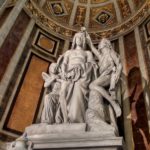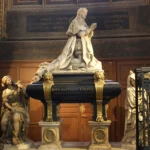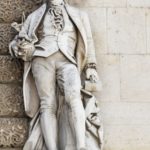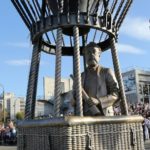Henri Bouchard the great French sculptor

Henri Bouchard (December 13, 1875 November 30, 1960) a famous French sculptor of the twentieth century, an outstanding representative of realism, medalist and engraver. Henri Bouchard created a huge amount of original work during his professional career: monumental monuments, reliefs, busts, tombstones, statues and decorative elements of buildings. The work of the master had a noticeable influence on the development of the sculptural art of France in the interwar period.
Henri Bouchard devoted a significant part of his life to teaching and taught dozens of students at the Ecole des Beaux-Arts in Paris. Among his students there are many famous artists, including: Jean-Marie Baumel; Philippe Besnard; Charles Bigonet; Albert Buquillon; Jean Freur.

Biography of Henri Bouchard
Henri Bouchard was born on December 13, 1875 to a carpenter’s family in the ancient city of Dijon in southeastern France. From early childhood, the boy loved to carve figures from wood and willingly helped his father in the workshop. Therefore, at the age of fourteen, Henri entered the local school of fine arts. Under the guidance of an experienced mentor Francois Dameron, he learned the basics of fine art. In 1895, Bouchard left for Paris and successfully passed the exams at the National Higher School of Arts on the first attempt. 20-year-old Henri was enrolled in the class of Professor Louis-Ernest Barriat and turned out to be one of the best students in the course.
In 1901 he won the Grand Prix of the Prix de Rome competition and earned the right to travel to Italy for further studies at the Villa Medici. A year later, the young sculptor ended up in the Eternal City. While studying in Rome, Henri Bouchard made many trips to Italy, and also visited Tunisia, Morocco and Greece. A particularly strong impression on the young sculptor was made by observations of the lives of ordinary people workers, artisans and peasants. It was then that he finally decided on the theme of his work and became interested in the ideas of realism in art.

Returning to France in 1906, Henri settled in Paris, in the Montmartre region, where he set up his own workshop. Bouchard began to create bas-reliefs and decorative elements for public buildings, and a year later he received the first order from the French authorities for the manufacture of a monument. By the beginning of the 1910s, the young master had gained wide popularity in the capital and significantly improved his financial situation. In search of new experiences at the same time he went on a trip to Europe, visited Germany, England, Belgium and the Netherlands. And in 1913, the sculptor married Suzanne Schneller, with whom he lived happily until the end of his life and raised three children.


With the outbreak of the First World War, the artist was mobilized into the army, but he did not take part in the hostilities. Henri served five years in the rear unit in Amiens, developing camouflage for the troops. After demobilization in 1919, Bouchard returned to the French capital again and his professional career quickly took off. Five years later, the sculptor built a new workshop in the Auteuil district in the west of Paris and moved there with his family. Many years later, after the death of the artist, this building became his memorial museum. Through the efforts of his son and daughter-in-law, more than 1300 works of the brilliant Frenchman were collected.
During the interwar period, the sculptor achieved the most outstanding success in creativity and created hundreds of beautiful masterpieces. In 1929 he was appointed professor at the National School of Fine Arts, a little later he became an honorary member of the Paris, Antwerp and Brussels Academies.

The beginning of the Second World War, the artist met in Paris and stayed there after the occupation by German troops. Bouchard enjoyed great prestige in the art world and was absolutely not afraid of harassment by the new government. Moreover, the 64-year-old master deliberately agreed to cooperate with the Nazis. At the invitation of Goebbels, he visited Germany as part of a propaganda tour and was the main organizer of an exhibition of the work of Arno Breker in Paris.
After the liberation of France from the invaders, Henri Bouchard was found guilty of collaborating with the Nazis and dismissed from his post as professor at the School of Fine Arts. The 70-year-old sculptor, who tarnished his reputation, could no longer qualify for large orders and was forced to live in hostile isolation.

In the post-war years, he created only a few new works and spent time in his studio, indulging in memories and reflections on his life. And on November 30, 1960, two weeks before his 85th birthday, Henri Bouchard died, leaving to posterity a huge studio filled with hundreds of sketches, models and finished sculptures.

The most famous works of Henri Bouchard
The brilliant French artist created many outstanding works of sculptural art. And yet the most famous works of Henri Bouchard are:
- Monument to the memory of the victims of the death of the airship “Republic” (1911) a work made by the master commissioned by the French government. A commemorative stele depicting the profile of a military pilot adorns the grave of the fallen crew members of the aircraft.
- Monument to Étienne-Jules Marais (1911) is a masterpiece that glorifies the great French inventor and scientist. The sculptor depicted Mare sitting on an armchair against the backdrop of chronograph frames frozen in stone with running horses.
- Statues of the “Reformation Wall” in Geneva (1912) a work made by Bouchard together with Paul Landowski. Four great reformers of the church in pastoral dresses stand majestically in the center of a multi-meter wall erected in honor of the 400th anniversary of the birth of John Calvin.
- “Apollo with the Muses” (1936) is a sculptural group created on the occasion of the opening of the World Exhibition in Paris. This work still adorns the main entrance to the Palais de Chaillot opposite the Eiffel Tower.









